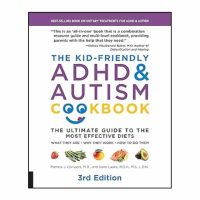Introduction
Autism Spectrum Disorder (ASD) affects millions of individuals worldwide, influencing their sensory perceptions, behaviors, and overall lifestyle. One critical yet often overlooked factor in autism management is diet. Research and parental experiences suggest that dietary adjustments can significantly impact autistic individuals’ behavior, digestion, sleep, and overall well-being.
Many autistic children and adults experience food sensitivities, nutritional deficiencies, and digestive problems, which can make mealtimes a challenge. By understanding these specific needs and implementing a well-balanced, nutrient-rich diet, caregivers can improve the quality of life for autistic individuals. This guide explores the best nutritional strategies, including essential foods, dietary supplements, and practical tips for overcoming food rigidity. Let’s discover this Diet for Autism
Table of Contents
1. Specific Nutritional Needs of Autistic Individuals
Autistic individuals often have unique dietary characteristics that can impact their overall well-being. These include:
- Food Sensitivities: Certain textures, smells, colors, or tastes can be difficult to tolerate. Autistic children may refuse foods simply because of their appearance or consistency in the mouth.
- Nutritional Deficiencies: Iron, zinc, vitamin B6 and B12, omega-3, and other essential nutrients may be lacking in their diet, impacting cognitive development and energy levels.
- Digestive Issues: Constipation, bloating, and irritable bowel syndrome are common. An imbalance in gut microbiota may also play a role in worsening autistic symptoms.
Essential Foods to Prioritize

- Omega-3 (fatty fish, nuts, flaxseeds) – Promote brain development and cognition.
- Lean Proteins (white meats, eggs, legumes) – Help with concentration and muscle building.
- Fruits and Vegetables (carrots, berries, spinach) – Rich in vitamins and antioxidants that boost immunity and reduce inflammation.
- Fermented Foods (lactose-free yogurt, sauerkraut, kefir) – Support a healthy gut microbiome, essential for digestion and neurochemical balance.
Foods to Limit
- Additives and Colorants (E102, E110, E133) – Linked to hyperactivity and anxiety.
- Refined Sugars (candies, sodas) – Can cause energy fluctuations and increased irritability.
- Gluten and Casein (for sensitive children) – May cause digestive issues and potentially worsen certain symptoms.

2. Gluten-Free and Casein-Free (GFCF) Diet: A Beneficial Option?
The GFCF diet is popular among autistic children, as many parents have reported improvements after its adoption. Several studies suggest that eliminating gluten and casein could reduce gut inflammation and improve communication, behavior, and sleep.
However, this diet should be followed cautiously to avoid nutritional deficiencies. For example, gluten is often replaced with less nutritious flours, and casein is an important source of calcium. It is crucial to compensate with nutrient-rich alternatives such as:

- Enriched Flours (brown rice, buckwheat, quinoa) to maintain sufficient fiber and protein intake.
- Calcium-Fortified Plant Milks (almond, coconut, soy) to compensate for the absence of casein.
- Plant-Based Proteins (lentils, chickpeas, tofu) to ensure adequate amino acid intake.
Testimonial from Sophie, mother of Lucas (6 years old)
“Since Lucas started following a gluten-free and casein-free diet, we have seen a dramatic improvement in his sleep and concentration at school.”
3. How to Overcome Food Rigidity?
Many autistic children develop rigid eating habits, tolerating only a few specific foods. This selectivity may be due to sensory hypersensitivities, a need for control, or past negative food experiences.
Advanced Strategies for Introducing New Foods
- Gradual Exposure: Show the food without forcing it to be eaten, then encourage the child to touch, smell, and finally taste it.
- Modify Problematic Textures: Blend, cook differently, or combine with a familiar texture to make a food more acceptable.
- Involve the Child in Meal Preparation: When a child helps cook a dish, they are more likely to try it.
- Create a Positive Experience: Associate new foods with enjoyable moments and avoid pressure.
Testimonial from Marc, father of Alice (4 years old)
“Alice refused vegetables. With colorful presentations and games, she started enjoying carrots and zucchini!”
4. Useful Dietary Supplements

If an autistic child’s diet is restricted, supplements may be necessary. Here are some recommendations based on common needs:
- Omega-3 (EPA and DHA): Improve memory, concentration, and reduce irritability.
- Magnesium and Zinc: Essential for stress regulation and better sleep.
- Specific Probiotics: Help balance gut microbiota, which can influence behavior and mood.
- Vitamin D: Important for immunity and bone health, often deficient in autistic children.
Testimonial from Claire, mother of Théo (8 years old)
“Omega-3 supplements have changed Théo’s daily life. He is more focused and less anxious.”
5. Examples of Balanced Meals
Breakfast



Lunch



Dinner



Snacks



Testimonial from Nathalie, mother of Jade (7 years old)
“Since we adopted these balanced meals, Jade is calmer and has fewer digestive issues.”
Conclusion
Adopting a diet tailored to the specific needs of autistic children can significantly improve their physical and mental well-being. Each child is unique, and it may be necessary to experiment with different dietary strategies before finding the best approach.
It is also important to work with healthcare professionals (nutritionists, pediatricians, specialized speech therapists) to ensure a smooth and stress-free dietary transition.
Finally, gradually involving the child in food selection and preparation can be a great way to encourage them to explore new foods while respecting their sensory preferences.
Discover our post: Tailoring Diets to Enhance Well-Being and Succes
Ressources:
Recommended Product:
The cookbook for children with ADHD and autism, 3rd edition, explains the best diets for children with food intolerances and sensitivities resulting from altered biochemistry, which can lead to learning, behavioral, developmental, attention, sensory response, sleep, and digestive issues. The authors provide guidelines to help parents determine which diets may be beneficial for their child’s specific symptoms and needs.

